Pearlsanddiamonds
Rough_Rock
- Joined
- Aug 21, 2017
- Messages
- 9
Is there a photo? I don't see one. If you uploaded one, try again.
In the meantime, you could gently rub one of the pearls against another one, or against the edge of your front tooth. Real nacre is a bit gritty while imitation pearls feel smooth.
There are other tests but start with that.
Is there a photo? I don't see one. If you uploaded one, try again.
In the meantime, you could gently rub one of the pearls against another one, or against the edge of your front tooth. Real nacre is a bit gritty while imitation pearls feel smooth.
There are other tests but start with that.
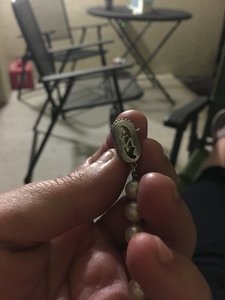
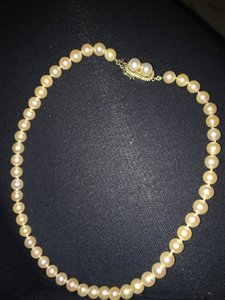
thereIs there a photo? I don't see one. If you uploaded one, try again.
In the meantime, you could gently rub one of the pearls against another one, or against the edge of your front tooth. Real nacre is a bit gritty while imitation pearls feel smooth.
There are other tests but start with that.


Thanks!
Thanks!
It's hard to evaluate the pearls because they were photographed against a dark background, which tends to swallow up the luster and surface details. They are a bit overexposed which also doesn't help see details.
If you wouldn't mind photographing them again, please use a white background-- paper towels are fine.
Try not to overexpose them. Take a few close-ups also, including any flaws or blemishes. There are blemishes typical to real pearls vs. imitation ones.
Did you do the test I suggested (tooth test)?
Besides a smooth feel to the pearl when rubbed against your front tooth, here are some other things that may be true of fake pearls, especially the cheaper ones:
• Larger drill holes than real pearls. (Because pearls are sold by weight, and small drill holes preserve weight).
• Beveled drill holes.
• Swirls of excess coating near drill holes.
• Flaking thin coating with the bead visible underneath.
• If you look at the surface with a 10x loupe (magnifier) the surface of real pearls looks smooth, while the surface of imitations looks rougher. If in doubt, you can compare what you see with a known-real or a known-fake pearl.
• perfectly matched pearls all the same size, shape and color, with no variation in color overtones. (But I have a strand of vintage fakes from Japan that have varied shapes, so shape is not always identical).
• The lack of any flaws makes it likely the pearls are fake. Real strands, even very good ones, will almost always have a few blemishes.
I can't tell anything from the clasp. Is it gold colored? (The back looks like silver but the other photo makes the front of the clasp look gold)? If so and it's stamped sterling, it could be vermeil-- gold plating over sterling silver. This could have worn off in back. Vermeil clasps would tend to be used with imitation pearls-- e.g. my Majorica imitation pearls have vermeil clasps. Fine pearls would not tend to be strung with vermeil clasps. (Of course clasps can be changed.)
It's hard to evaluate the pearls because they were photographed against a dark background, which tends to swallow up the luster and surface details. They are a bit overexposed which also doesn't help see details.
If you wouldn't mind photographing them again, please use a white background-- paper towels are fine.
Try not to overexpose them. Take a few close-ups also, including any flaws or blemishes. There are blemishes typical to real pearls vs. imitation ones.
Did you do the test I suggested (tooth test)?
Besides a smooth feel to the pearl when rubbed against your front tooth, here are some other things that may be true of fake pearls, especially the cheaper ones:
• Larger drill holes than real pearls. (Because pearls are sold by weight, and small drill holes preserve weight).
• Beveled drill holes.
• Swirls of excess coating near drill holes.
• Flaking thin coating with the bead visible underneath.
• If you look at the surface with a 10x loupe (magnifier) the surface of real pearls looks smooth, while the surface of imitations looks rougher. If in doubt, you can compare what you see with a known-real or a known-fake pearl.
• perfectly matched pearls all the same size, shape and color, with no variation in color overtones. (But I have a strand of vintage fakes from Japan that have varied shapes, so shape is not always identical).
• The lack of any flaws makes it likely the pearls are fake. Real strands, even very good ones, will almost always have a few blemishes.
I can't tell anything from the clasp. Is it gold colored? (The back looks like silver but the other photo makes the front of the clasp look gold)? If so and it's stamped sterling, it could be vermeil-- gold plating over sterling silver. This could have worn off in back. Vermeil clasps would tend to be used with imitation pearls-- e.g. my Majorica imitation pearls have vermeil clasps. Fine pearls would not tend to be strung with vermeil clasps. (Of course clasps can be changed.)
Thanks!
It's hard to evaluate the pearls because they were photographed against a dark background, which tends to swallow up the luster and surface details. They are a bit overexposed which also doesn't help see details.
If you wouldn't mind photographing them again, please use a white background-- paper towels are fine.
Try not to overexpose them. Take a few close-ups also, including any flaws or blemishes. There are blemishes typical to real pearls vs. imitation ones.
Did you do the test I suggested (tooth test)?
Besides a smooth feel to the pearl when rubbed against your front tooth, here are some other things that may be true of fake pearls, especially the cheaper ones:
• Larger drill holes than real pearls. (Because pearls are sold by weight, and small drill holes preserve weight).
• Beveled drill holes.
• Swirls of excess coating near drill holes.
• Flaking thin coating with the bead visible underneath.
• If you look at the surface with a 10x loupe (magnifier) the surface of real pearls looks smooth, while the surface of imitations looks rougher. If in doubt, you can compare what you see with a known-real or a known-fake pearl.
• perfectly matched pearls all the same size, shape and color, with no variation in color overtones. (But I have a strand of vintage fakes from Japan that have varied shapes, so shape is not always identical).
• The lack of any flaws makes it likely the pearls are fake. Real strands, even very good ones, will almost always have a few blemishes.
I can't tell anything from the clasp. Is it gold colored? (The back looks like silver but the other photo makes the front of the clasp look gold)? If so and it's stamped sterling, it could be vermeil-- gold plating over sterling silver. This could have worn off in back. Vermeil clasps would tend to be used with imitation pearls-- e.g. my Majorica imitation pearls have vermeil clasps. Fine pearls would not tend to be strung with vermeil clasps. (Of course clasps can be changed.)
Thanks!
It's hard to evaluate the pearls because they were photographed against a dark background, which tends to swallow up the luster and surface details. They are a bit overexposed which also doesn't help see details.
If you wouldn't mind photographing them again, please use a white background-- paper towels are fine.
Try not to overexpose them. Take a few close-ups also, including any flaws or blemishes. There are blemishes typical to real pearls vs. imitation ones.
Did you do the test I suggested (tooth test)?
Besides a smooth feel to the pearl when rubbed against your front tooth, here are some other things that may be true of fake pearls, especially the cheaper ones:
• Larger drill holes than real pearls. (Because pearls are sold by weight, and small drill holes preserve weight).
• Beveled drill holes.
• Swirls of excess coating near drill holes.
• Flaking thin coating with the bead visible underneath.
• If you look at the surface with a 10x loupe (magnifier) the surface of real pearls looks smooth, while the surface of imitations looks rougher. If in doubt, you can compare what you see with a known-real or a known-fake pearl.
• perfectly matched pearls all the same size, shape and color, with no variation in color overtones. (But I have a strand of vintage fakes from Japan that have varied shapes, so shape is not always identical).
• The lack of any flaws makes it likely the pearls are fake. Real strands, even very good ones, will almost always have a few blemishes.
I can't tell anything from the clasp. Is it gold colored? (The back looks like silver but the other photo makes the front of the clasp look gold)? If so and it's stamped sterling, it could be vermeil-- gold plating over sterling silver. This could have worn off in back. Vermeil clasps would tend to be used with imitation pearls-- e.g. my Majorica imitation pearls have vermeil clasps. Fine pearls would not tend to be strung with vermeil clasps. (Of course clasps can be changed.)
I just sent you the picture
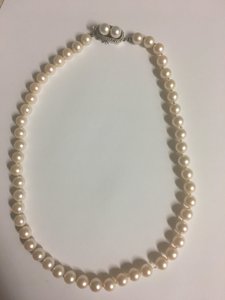
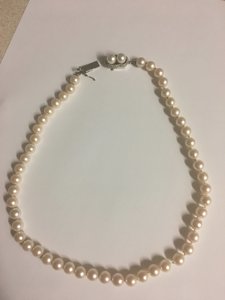
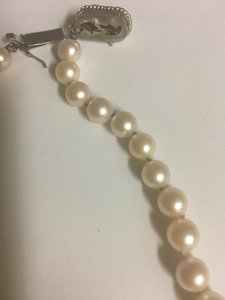
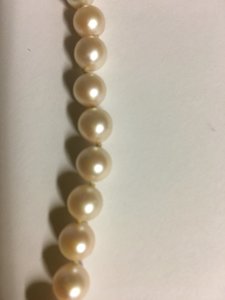
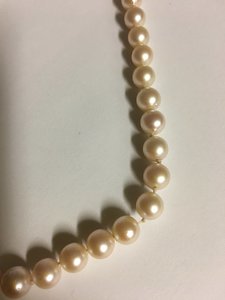
Much better photos! The surface characteristics are those of real cultured pearls. (You can't go by the weight as glass bead fake pearls feel heavy, too.) Cultured pearls feel cooler against one's skin than glass-bead imitation pearls do.
If they look fully round in person they are likely akoya pearls, but I don't think they are very high end as they do not seem to have a high degree of luster. Some of the pearls look a bit off round in the photo but that may just be distortion from the camera. (Freshwater pearls without a bead inside tend to be a bit off round.) The thread looks like the strand was worn quite a bit-- thread gets grimy over time. That is another reason to think they are akoyas. The rounder freshwaters have not been around for many years.
In summary, I think you have not-very-expensive akoya pearls. (Higher end pearls would have a gold clasp) If you want to wear them, I recommend giving them a bath (warm soapy water-- use bottled water to avoid chlorine and hard minerals) and restringing them! Many of us restring our own pearls-- it is easy.
If on the other hand you want to sell them, I recommend you do a search on eBay for sold items like yours. That will give you an idea of the final sale price you may get. Pre-owned pearls do not tend to hold their value, though. My vote is for restringing them and wearing them.
Much better photos! The surface characteristics are those of real cultured pearls. (You can't go by the weight as glass bead fake pearls feel heavy, too.) Cultured pearls feel cooler against one's skin than glass-bead imitation pearls do.
If they look fully round in person they are likely akoya pearls, but I don't think they are very high end as they do not seem to have a high degree of luster. Some of the pearls look a bit off round in the photo but that may just be distortion from the camera. (Freshwater pearls without a bead inside tend to be a bit off round.) The thread looks like the strand was worn quite a bit-- thread gets grimy over time. That is another reason to think they are akoyas. The rounder freshwaters have not been around for many years.
In summary, I think you have not-very-expensive akoya pearls. (Higher end pearls would have a gold clasp) If you want to wear them, I recommend giving them a bath (warm soapy water-- use bottled water to avoid chlorine and hard minerals) and restringing them! Many of us restring our own pearls-- it is easy.
If on the other hand you want to sell them, I recommend you do a search on eBay for sold items like yours. That will give you an idea of the final sale price you may get. Pre-owned pearls do not tend to hold their value, though. My vote is for restringing them and wearing them.
There are akoyas in all ranges of value, as well as freshwaters in all ranges. Overall akoyas cost more than freshwaters but a lot of that is the higher cost of producing them.
Age doesn't do good things to pearls. They can lose luster and yellow due to exposure to grime/ skin oils, cosmetics, perfumes, hair spray....
There are akoyas in all ranges of value, as well as freshwaters in all ranges. Overall akoyas cost more than freshwaters but a lot of that is the higher cost of producing them.
Age doesn't do good things to pearls. They can lose luster and yellow due to exposure to grime/ skin oils, cosmetics, perfumes, hair spray....
There are akoyas in all ranges of value, as well as freshwaters in all ranges. Overall akoyas cost more than freshwaters but a lot of that is the higher cost of producing them.
Age doesn't do good things to pearls. They can lose luster and yellow due to exposure to grime/ skin oils, cosmetics, perfumes, hair spray....